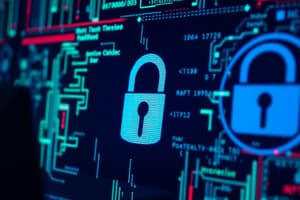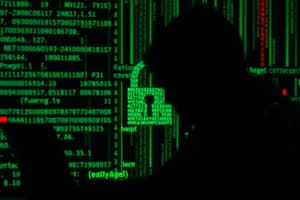Podcast
Questions and Answers
Which of the following describes what patents grant to their holders?
Which of the following describes what patents grant to their holders?
- The right to prevent others from making, using, or selling an invention. (correct)
- The right to copyright any written work immediately.
- The right to share formulas without restriction.
- The right to use trade secrets for their business.
Which of the following is not one of the key provisions of the Data Privacy Act of 2012?
Which of the following is not one of the key provisions of the Data Privacy Act of 2012?
- Secure storage of personal information.
- Rights of individuals to access and correct their data.
- Transparency in data collection.
- Legal protections for hate speech. (correct)
What type of policy primarily governs how data is handled within an organization?
What type of policy primarily governs how data is handled within an organization?
- Data Classification Policy (correct)
- Access Control Policy
- Acceptable Use Policy
- Incident Response Policy
What cultural aspect do indigenous rights pertain to in the context of intellectual property?
What cultural aspect do indigenous rights pertain to in the context of intellectual property?
Which of the following is an example of a trade secret?
Which of the following is an example of a trade secret?
What is the primary role of proactive intrusion detection in physical security?
What is the primary role of proactive intrusion detection in physical security?
What distinguishes known exploits from unknown exploits?
What distinguishes known exploits from unknown exploits?
Which characteristic is essential for scalable physical security implementation?
Which characteristic is essential for scalable physical security implementation?
What is one advantage of cloud-operated physical security systems?
What is one advantage of cloud-operated physical security systems?
Which of the following best describes a denial of service (DoS) attack?
Which of the following best describes a denial of service (DoS) attack?
What does operational security primarily focus on?
What does operational security primarily focus on?
What type of forensics involves the investigation of network traffic?
What type of forensics involves the investigation of network traffic?
Which of the following is NOT a method of data collection as outlined?
Which of the following is NOT a method of data collection as outlined?
Which of the following is a characteristic of malware?
Which of the following is a characteristic of malware?
What does identity theft typically involve?
What does identity theft typically involve?
What is required from organizations before collecting personal data?
What is required from organizations before collecting personal data?
What is a significant concern associated with the over-sharing of information on social media?
What is a significant concern associated with the over-sharing of information on social media?
How does cryptojacking primarily operate?
How does cryptojacking primarily operate?
What is the primary goal of malware forensics?
What is the primary goal of malware forensics?
How can criminal defamation laws be misused?
How can criminal defamation laws be misused?
What is the primary purpose of physical security measures?
What is the primary purpose of physical security measures?
Flashcards
Security Incident
Security Incident
A security event that damages network resources or data due to an attack or threat.
Exploit
Exploit
A code, software, or method used by attackers to exploit vulnerabilities in applications, systems, or networks.
Known Exploits
Known Exploits
Vulnerabilities or attack methods already discovered and made public.
Unknown Exploits (Zero-day)
Unknown Exploits (Zero-day)
Signup and view all the flashcards
Denial of Service (DoS) Attack
Denial of Service (DoS) Attack
Signup and view all the flashcards
Malware
Malware
Signup and view all the flashcards
Disk Forensics
Disk Forensics
Signup and view all the flashcards
Physical Security
Physical Security
Signup and view all the flashcards
Freedom of Expression
Freedom of Expression
Signup and view all the flashcards
Criminal Defamation Laws
Criminal Defamation Laws
Signup and view all the flashcards
Information Privacy
Information Privacy
Signup and view all the flashcards
Data Ownership
Data Ownership
Signup and view all the flashcards
Data Collection Practices
Data Collection Practices
Signup and view all the flashcards
Consent
Consent
Signup and view all the flashcards
Tracking Technologies
Tracking Technologies
Signup and view all the flashcards
Data Breaches
Data Breaches
Signup and view all the flashcards
Copyright
Copyright
Signup and view all the flashcards
Patent
Patent
Signup and view all the flashcards
Trade Secret
Trade Secret
Signup and view all the flashcards
Patent Infringement
Patent Infringement
Signup and view all the flashcards
Registered Designs
Registered Designs
Signup and view all the flashcards
Study Notes
Security Incidents and Exploits
- A security incident is an event that damages network resources or data, part of an attack or security threat.
- Exploits are codes, software, or methods attackers use to take advantage of system vulnerabilities.
- Known exploits are vulnerabilities or attack methods already discovered, documented, and made public.
- Unknown (zero-day) exploits are vulnerabilities or attack methods not yet known or disclosed.
Denial-of-Service Attacks
- A denial-of-service (DoS) attack floods a computer or website with data to overload the system, preventing proper function.
Malware
- Malware is harmful software, like spyware, viruses, ransomware, and worms, that can access system data.
Identity Theft
- Identity theft occurs when criminals gain access to personal information to use for their benefit.
Cryptojacking
- Cybercriminals use a victim's computer resources without their knowledge to mine cryptocurrencies.
Cross-Site Request Forgery (CSRF)
- CSRF forces a user to execute unwanted actions on a web application while logged in.
Disk Forensics
- Disk forensics recovers data from physical storage devices, including deleted or hidden partitions.
Network Forensics
- Network forensics investigates network traffic to find security incidents, unauthorized access, or other malicious activity.
Database Forensics
- Database forensics collects information from databases, including data and metadata.
Mobile Forensics
- Mobile forensics uses special software to extract, investigate, and recover data from devices.
Malware Forensics
- Malware forensics finds, examines, and tracks down attacking malware.
Physical Security
- Physical security protects buildings and equipment from unauthorized access.
- Preventing unauthorized entry is vital for secure office spaces.
Proactive Intrusion Detection
- Proactive intrusion detection is the first line of defense to prevent building intrusions.
Scalable Physical Security Implementation
- Scalable physical security solutions are easy to install and quickly adapt to new systems.
Seamless System Integrations
- Physical security systems can integrate with other software and applications, providing seamless transition.
Audit Trails and Analytics
- Audit trails and analytics allow easy and quick identification of possible system weaknesses.
Operational Security (Procedural Security)
- Operational security, or procedural security, is a risk management process that encourages managers to view operations from an adversary's perspective to protect sensitive information.
Information Privacy
- Information privacy is the right of individuals to control how their personal data is collected, stored, and shared.
- Data ownership is the right of individuals to decide how their personal data is used by organizations.
Data Collection Practices
- Data is collected through various means, including online forms, cookies, and apps.
Consent
- Consent is required before organizations collect personal data.
Tracking Technologies
- Tracking technologies, like cookies and mobile apps, track user activity.
Data Breaches
- Data breaches are unauthorized access to sensitive data, potentially leading to identity theft or fraud.
Social Media and Privacy
- Over-sharing and lack of privacy controls on social media expose personal information to risks.
Data Privacy Act of 2012 (RA 10173)
- This act protects personal data privacy by regulating its processing.
Freedom of Expression
- Freedom of expression is the ability to express beliefs, thoughts, ideas, and emotions without government censorship.
Criminal Defamation Laws
- Criminal defamation laws are often misused, used in situations not involving public interest, and should be a last resort.
Attacks on Media Workers
- Harassment of journalists poses a significant threat to independent and investigative journalism.
Informal Censorship
- Informal censorship prevents or punishes the publication of critical material.
Hate Speech
- Hate speech is a pervasive tactic for undermining rights.
Gender Equity
- Equal access and representation for women in media are crucial for proper coverage of women's issues and perspectives.
Intellectual Property
- Intellectual property is a non-physical asset a company or person owns.
- Copyright protects original works from unauthorized use.
Patents
- Patents protect inventions, allowing inventors to prevent others from making, using, or selling their inventions.
Patent Infringement
- Patent infringement is the unauthorized use of a patented invention without permission.
Trade Secrets
- Trade secrets are confidential business information that gives a company an advantage over its competitors.
Security Policies
- Acceptable Use Policy, Data Classification Policy, Incident Response Policy, and Access Control Policy are examples of security policies.
Data Privacy Act of 2012 Key Provisions
- Transparency in data collection, secure storage of personal information, and individual rights to access and correct data are key provisions.
Freedom of Speech Issues
- Key issues related to freedom of speech, as well as related key terms regarding Intellectual Property, are covered.
Examples of Trade Secrets, Patents, and Other IP
- Specific examples of various types of intellectual property, including formulas, methods, techniques, and specific types of patents, are included.
Studying That Suits You
Use AI to generate personalized quizzes and flashcards to suit your learning preferences.




